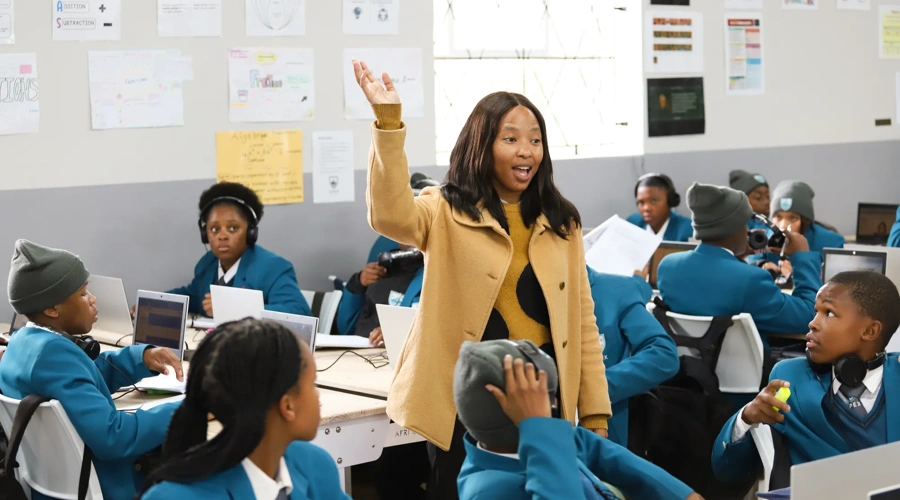Teaching Meets Tech: Expanding Quality Education for Half the Cost

Overview
Innovative educational models are preparing India's large youth population for the future, by enhancing academic outcomes and creating new pathways to college and career.
India has one of the largest populations of young people in the world. According to the ASER 2023 Beyond Basics report, most Indian students between ages 14 and 18 aspire to earn a bachelor’s degree, while others will pursue a vocation after secondary school. Ensuring they have the foundation to succeed in their college and career aspirations is crucial – for millions of young people across the country and the future of India’s economy.
However, students are not adequately prepared for higher education or the workforce. Fewer than four in 10 students who enroll in class 1, or first grade, will reach college or an industrial training institute (ITI), and the labor force participation rate among youth (ages 15 to 29) is only 36.8%, compared to a national average of 40.3%.
Despite these challenges, promising new models are emerging across the country to ensure students are positioned for success in the classroom and beyond. Here are six innovative models helping to improve academic outcomes and equipping our students with better college and career pathways.
Building a Foundation for Academic Outcomes in the Classroom
Across the country, several government school partnerships are modeling an innovative, comprehensive approach to boosting classroom engagement, with a focus on:
- Identifying and aligning classroom instruction to key learning outcomes
- Equipping teachers and school leaders with tools and resources (e.g., classroom practices, instructional materials, assessment templates)
- Nurturing an engaging school culture, including leadership development for school leaders and deeper parent engagement
In Rajasthan, the Rajasthan ke Shiksa Mai Badhte Kadam (RKSMBK) initiative is leveraging a machine learning tool to transform students’ classroom experience. More than 70% of the state’s teachers use an app to digitize and analyze assessments, freeing up their time from administrative tasks while equipping them with actionable data and educational materials to tailor curriculum to each student. Digitally generated report cards also help parents understand their child’s performance and engage with their education in more meaningful ways.
The CM Rise program in Madhya Pradesh has set up 10,000 model schools supported by state-of-the-art infrastructure, the system’s best teachers, and dedicated administrative and support staff. Teachers are selected through an exam and nurtured through a robust teacher training program. Schools offer sports and technology facilities, labs, and libraries to complement the classroom experience and create a holistic learning environment.
The Akanksha Foundation, known for its after-school centers and innovative no-fee schools, prioritizes academic excellence and social-emotional learning and has significantly impacted students’ school completion and university success. Building on more than 30 years of experience, Akanksha expanded to an indirect support model, beginning with 200 schools in two urban centers of Maharashtra, that will help the organization achieve greater scale in the public school setting. Key interventions include hands-on teacher training, administrative support for process improvements, and supporting schools in increasing parent and community engagement.
A child’s aspirations bloom in an engaging learning environment. These models demonstrate the potential to not only improve students’ learning outcomes but help them envision the opportunities ahead and increase their chances of continuing their education.
Creating a Pathway to College and Careers
A complete learning journey should lead to employability after children complete their schooling. Today only 5.6% of young people are currently completing vocational training or related courses, while the National Education Policy (NEP) envisions expanding vocational education to 50% of youth. Interventions that develop work-readiness skills and increase practical exposure help students leverage their foundational education to ultimately gain employment and lead enriching lives.
Engaging in career exploration while in school can help young people imagine new possibilities for themselves, motivating students to understand where their studies could lead or consider career pathways they may not be exposed to otherwise. With INR 2072 crores (USD $250 million) in Ministry of Education funding earmarked for career counseling, the government of Uttar Pradesh is partnering with iDreamCareer (iDC) to pilot an intervention for 16,500 high school students. The program will include group and one-on-one counseling sessions, a psychometric assessment, career fairs, and ongoing mentorship and parent engagement. An online portal will offer career, college, and vocational training resources to students and a case management platform for counselors.
In Punjab, a survey of high school students indicated that 45% intend to pursue full- or part-time work after grade 12. The Punjab Department of School Education is launching an innovative program to ease this transition from school into the workforce. The program will first go live across 40 public high schools and focus on four trades aligned to local economic demands. The model will enable students to transition smoothly into early careers and expand pathways to higher education.
Beyond technical skills, employers also place increasing value on life skills — critical abilities like communication, problem-solving, and adaptability that equip individuals to navigate adversity and thrive in the workplace and beyond. A pilot program evaluating 15 life skills programs found Magic Bus’s teacher-led model to be the most effective in the school setting. Haryana has partnered with the organization to train teachers and embed life skills into middle and high school curriculum in three districts across the state. The program will boost job readiness for more than 80,000 students and demonstrate a model with widespread potential.
Indian Youth and the Workforce of Tomorrow
India’s young people want to create a brighter future for themselves and their families. Whether students pursue higher education or enter the workforce directly from secondary school, these models can help equip them with the high-quality, holistic education they need to succeed.



